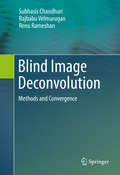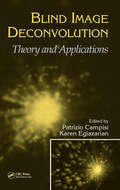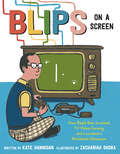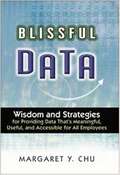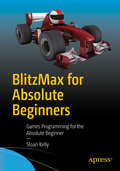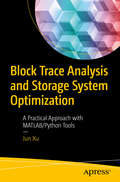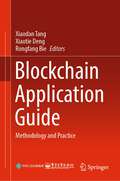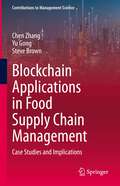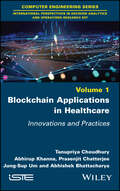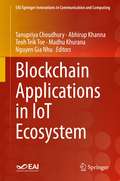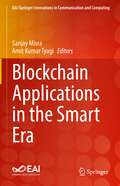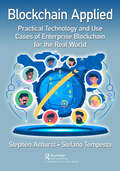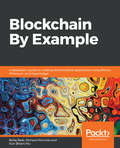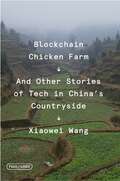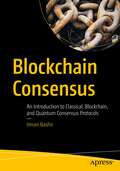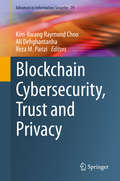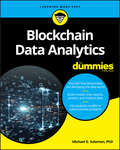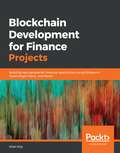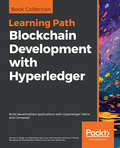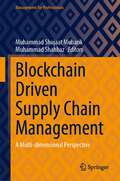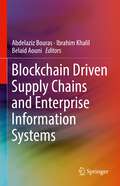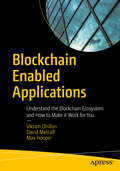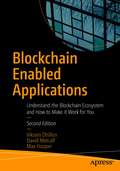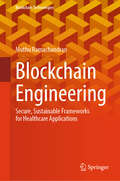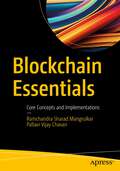- Table View
- List View
Blind Image Deconvolution: Methods and Convergence
by Subhasis Chaudhuri Rajbabu Velmurugan Renu RameshanBlind deconvolution is a classical image processing problem which has been investigated by a large number of researchers over the last four decades. The purpose of this monograph is not to propose yet another method for blind image restoration. Rather the basic issue of deconvolvability has been explored from a theoretical view point. Some authors claim very good results while quite a few claim that blind restoration does not work. The authors clearly detail when such methods are expected to work and when they will not. In order to avoid the assumptions needed for convergence analysis in the Fourier domain, the authors use a general method of convergence analysis used for alternate minimization based on three point and four point properties of the points in the image space. The authors prove that all points in the image space satisfy the three point property and also derive the conditions under which four point property is satisfied. This provides the conditions under which alternate minimization for blind deconvolution converges with a quadratic prior. Since the convergence properties depend on the chosen priors, one should design priors that avoid trivial solutions. Hence, a sparsity based solution is also provided for blind deconvolution, by using image priors having a cost that increases with the amount of blur, which is another way to prevent trivial solutions in joint estimation. This book will be a highly useful resource to the researchers and academicians in the specific area of blind deconvolution.
Blind Image Deconvolution: Theory and Applications
by Patrizio Campisi Karen EgiazarianBlind image deconvolution is constantly receiving increasing attention from the academic as well the industrial world due to both its theoretical and practical implications. The field of blind image deconvolution has several applications in different areas such as image restoration, microscopy, medical imaging, biological imaging, remote sensing, astronomy, nondestructive testing, geophysical prospecting, and many others. Blind Image Deconvolution: Theory and Applications surveys the current state of research and practice as presented by the most recognized experts in the field, thus filling a gap in the available literature on blind image deconvolution.Explore the gamut of blind image deconvolution approaches and algorithms that currently exist and follow the current research trends into the future. This comprehensive treatise discusses Bayesian techniques, single- and multi-channel methods, adaptive and multi-frame techniques, and a host of applications to multimedia processing, astronomy, remote sensing imagery, and medical and biological imaging at the whole-body, small-part, and cellular levels. Everything you need to step into this dynamic field is at your fingertips in this unique, self-contained masterwork.For image enhancement and restoration without a priori information, turn to Blind Image Deconvolution: Theory and Applications for the knowledge and techniques you need to tackle real-world problems.
Blips on a Screen: How Ralph Baer Invented TV Video Gaming and Launched a Worldwide Obsession
by Kate HanniganAn engaging picture book biography based on the incredible true story of a Jewish refugee who pioneered home video games and launched a worldwide obsession.Do you ever wonder how video gaming was invented? What came before your PlayStation or Xbox? This is the story of Ralph Baer, a refugee from Nazi Germany, who used his skills--and a lot of ingenuity and persistence--to make life a little more fun. Television was new when Ralph returned from serving in World War II, but he didn't settle for watching TV. He knew it could be even more fun if you could play with it. He tinkered and tested, got help and rejected, but with perseverance and skill, he made his vision come true! This is the inspiring story of a fearless inventor who made TV video games a reality.
Blissful Data: Wisdom And Strategies For Providing Meaningful, Useful, And Accessible Data For All Employees
by Margaret Y. ChuAnalyzing information and acting accordingly is a key strategic goal of every business. But vast quantities of data are of little use if they are not structured and kept in such a way as to be readily accessible and applicable. Only optimally organized information can drive maximum productivity. Blissful Data is a reader-friendly book that reveals what it takes to achieve a state of perfect organization within the environment of a successful data warehouse. This timely book will help the reader: * understand how data evolves into information that drives better decision making * recognize the pitfalls, caused by people and politics, that lead to short-sighted solutions and long-term problems * manage data warehousing costs, performance, and expectations effectively * apply project management fundamentals to data warehouse endeavors. Blissful Data includes dozens of examples, as well as case studies illustrating successful, unsuccessful, and disastrous data warehouse strategies.
BlitzMax for Absolute Beginners: Games Programming for the Absolute Beginner
by Sloan KellyGo through the steps necessary to create high-speed 2D retro-style games. This easy-to-read-and-follow one of a kind book on BlitzMax game programming also covers some 3D programming. BlitzMax for Absolute Beginners includes game application projects such as The Great Escape, Tank Attack, and Paratrooper. These will help you build your skills as you go. Have you ever wanted to program your own computer game? Never felt you could? Well, now you can. What You'll Learn Program computer games from scratch with BlitzMax Produce high-quality arcade games with sound and graphics Utilize the power of OpenGL to create fantastic 3D effects Who This Book Is For Those new to game programming and those new to BlitzMax.
Block Trace Analysis and Storage System Optimization: A Practical Approach with MATLAB/Python Tools
by Jun XuUnderstand the fundamental factors of data storage system performance and master an essential analytical skill using block trace via applications such as MATLAB and Python tools. You will increase your productivity and learn the best techniques for doing specific tasks (such as analyzing the IO pattern in a quantitative way, identifying the storage system bottleneck, and designing the cache policy).In the new era of IoT, big data, and cloud systems, better performance and higher density of storage systems has become crucial. To increase data storage density, new techniques have evolved and hybrid and parallel access techniques—together with specially designed IO scheduling and data migration algorithms—are being deployed to develop high-performance data storage solutions. Among the various storage system performance analysis techniques, IO event trace analysis (block-level trace analysis particularly) is one of the most common approaches for system optimization and design. However, the task of completing a systematic survey is challenging and very few works on this topic exist. Block Trace Analysis and Storage System Optimization brings together theoretical analysis (such as IO qualitative properties and quantitative metrics) and practical tools (such as trace parsing, analysis, and results reporting perspectives). The book provides content on block-level trace analysis techniques, and includes case studies to illustrate how these techniques and tools can be applied in real applications (such as SSHD, RAID, Hadoop, and Ceph systems). What You’ll Learn Understand the fundamental factors of data storage system performanceMaster an essential analytical skill using block trace via various applicationsDistinguish how the IO pattern differs in the block level from the file levelKnow how the sequential HDFS request becomes “fragmented” in final storage devicesPerform trace analysis tasks with a tool based on the MATLAB and Python platformsWho This Book Is For IT professionals interested in storage system performance optimization: network administrators, data storage managers, data storage engineers, storage network engineers, systems engineers
Blockchain Application Guide: Methodology and Practice
by Xiaotie Deng Xiaodan Tang Rongfang BieThis book focuses on progress, concerns and approaches of blockchain application. It summarizes basic concepts, principles and standardization of blockchain technology, as well as the status of blockchain application and industry. It provides an ecology model and an evaluation method for blockchain applications and analyses the governance of blockchain applications. It presents application values and practices in financial services, logistics, government service, culture and education, and people’s livelihood and includes analysis of scenarios and use cases. This book is a summary of the experience of more than 20 experts from enterprises and institutions active in the blockchain industry. It provides a panorama of blockchain applications for users, technology and service providers, application developers and operators and supervisors.
Blockchain Applications in Food Supply Chain Management: Case Studies and Implications (Contributions to Management Science)
by Steve Brown Chen Zhang Yu GongThis book contributes to blockchain applications in food supply chain management from both theoretical and practical perspectives. By using the case study research method, it empirically investigates why and how food companies implement blockchain technology. Moreover, it proposes a conceptual framework based on the case findings and extant literature. The book provides empirical evidence to verify academic findings such as critical success factors and barriers. Furthermore, it identifies the implementation process to answer the ‘how’ question. Uniquely, it applies the innovation process model and the practice-based view (PBV) to studies on food supply chains and blockchain. Thus, building on the original model and theory, it enriches the theory on blockchain implementation, making it a valuable asset for all researchers and practitioners interested in blockchain adoption and food supply chain management.
Blockchain Applications in Healthcare: Innovations and Practices
by Tanupriya ChoudhuryBlockchain is new-age technology used to track every transaction using cryptocurrency across servers linked in a peer-to-peer network, enabling transactions to be secure, transparent and reliable. Retaining an efficient, secure and patient-centric healthcare industry has never been so important, especially due to the damaging effects of the Covid-19 pandemic. The applicability of Blockchain in the healthcare domain can be seen as a remarkable opportunity for researchers and scientists to solve real-world problems. This book focuses on the fundamentals of Blockchain technology along with the methods of its integration with the healthcare industry. It also provides an enhanced understanding of Blockchain technology, AI and IoT across the various application areas of the healthcare industry. Furthermore, throughout the book, areas of relevant applications, such as patient data privacy protection, pharmaceutical supply chains and genomics are discussed.
Blockchain Applications in IoT Ecosystem (EAI/Springer Innovations in Communication and Computing)
by Nguyen Gia Nhu Tanupriya Choudhury Abhirup Khanna Teoh Teik Toe Madhu KhuranaThis book focuses on the fundamentals of blockchain technology along with the means and methods of its integration with Internet of Things (IoT). The book allows the reader to have a deeper understanding of blockchain technology, IoT and various application areas wherein both technologies can be implemented. The book serves the purpose of providing knowledge about the fundamentals of blockchain and IoT to a common reader along with allowing a research scholar to identify some futuristic problem areas that emerge from the convergence of both technologies. Furthermore, the authors discuss relevant application areas such as smart city, e-healthcare, smart travel, etc. throughout the course of the book. The book also talks through a few case studies illustrating the implementation and benefits of using blockchain and IoT. Provides a comprehensive view of blockchain technology and its integration with IoT;Facilitates in having a valuable understanding of various application areas pertaining to blockchain and IoT;Assists the reader in exploring new research areas wherein blockchain and IoT can find their applicability based upon their list of benefits.
Blockchain Applications in the Smart Era (EAI/Springer Innovations in Communication and Computing)
by Sanjay Misra Amit Kumar TyagiThis book covers a variety of topics and trends related to blockchain technology for smart era applications. The applications span industries such as health, government, energy management, manufacturing, finance, information systems, all far beyond blockchain's original use in cryptocurrency. The authors present variants, new models, practical solutions, and technological advances related to blockchain in these fields and more. The applications within these fields include blockchain and cyber-security, IoT security and privacy using blockchain, and blockchain in industries and society . A variety of case studies are also included. The book is applicable to researchers, professionals, students, and professors in a variety of fields in communications engineering.
Blockchain Applied: Practical Technology and Use Cases of Enterprise Blockchain for the Real World
by Stephen Ashurst Stefano TempestaBlockchain is an emerging technology for organizations to almost instantaneously make and verify transactions, streamlining business processes, saving money, and reducing the potential for fraud. This book covers the application of blockchain technology to the enterprise world, it describes the opportunities and challenges for adoption of DLT (Digital Ledger Technology) in a corporate environment, and specific use cases that may benefit from a decentralized and distributed trustless network. There are many books on blockchain, the new de-centralised ledger technology made famous (or infamous) by Bitcoin, Onecoin and others. But as cryptocurrencies and stock markets rise and fall with surprise volatility and the world economy emerges changed by coronavirus and the resulting economic crash, many in industry are looking again at the powerful features of blockchain and how these may help them adapt. This new book sets out the core features of blockchain and uniquely describes, in natural language and in real-life scenarios, how de-centralised ledgers may affect industries as varied as virus-tracking apps, finance, investment and healthcare.
Blockchain By Example: A developer's guide to creating decentralized applications using Bitcoin, Ethereum, and Hyperledger
by Bellaj BadrIf you are keen on learning how to build blockchain decentralized applications from scratch, then this book is what you need. It explains all the basic concepts required to develop your own intermediate projects.
Blockchain Chicken Farm: And Other Stories of Tech in China's Countryside (FSG Originals x Logic)
by Xiaowei Wang"A brilliant and empathetic guide to the far corners of global capitalism." --Jenny Odell, author of How to Do NothingFrom FSGO x Logic: stories about rural China, food, and tech that reveal new truths about the globalized worldIn Blockchain Chicken Farm, the technologist and writer Xiaowei Wang explores the political and social entanglements of technology in rural China. Their discoveries force them to challenge the standard idea that rural culture and people are backward, conservative, and intolerant. Instead, they find that rural China has not only adapted to rapid globalization but has actually innovated the technology we all use today. From pork farmers using AI to produce the perfect pig, to disruptive luxury counterfeits and the political intersections of e-commerce villages, Wang unravels the ties between globalization, technology, agriculture, and commerce in unprecedented fashion. Accompanied by humorous “Sinofuturist” recipes that frame meals as they transform under new technology, Blockchain Chicken Farm is an original and probing look into innovation, connectivity, and collaboration in the digitized rural world. FSG Originals × Logic dissects the way technology functions in everyday lives. The titans of Silicon Valley, for all their utopian imaginings, never really had our best interests at heart: recent threats to democracy, truth, privacy, and safety, as a result of tech’s reckless pursuit of progress, have shown as much. We present an alternate story, one that delights in capturing technology in all its contradictions and innovation, across borders and socioeconomic divisions, from history through the future, beyond platitudes and PR hype, and past doom and gloom. Our collaboration features four brief but provocative forays into the tech industry’s many worlds, and aspires to incite fresh conversations about technology focused on nuanced and accessible explorations of the emerging tools that reorganize and redefine life today.
Blockchain Consensus: An Introduction to Classical, Blockchain, and Quantum Consensus Protocols
by Imran BashirThis book is your comprehensive guide to understanding Blockchain and Blockchain consensus algorithms. It covers distributed systems, distributed consensus, and relevant system models. And you'll explore how classical and modern consensus algorithms work. The book also covers quantum consensus and explains the role that quantum computing plays in distributed systems. Consensus protocols allow participants in distributed systems to agree on a common value, despite faults. It's a fundamentally important construct in distributed systems. As a result of rigorous and ground-breaking research over the last four decades, many consensus mechanisms have been developed and are used in the industry today. However, with the advent of Blockchain technology, a renewed interest has arisen in this area, resulting in more research and innovation. The first Blockchain, Bitcoin, was invented in 2008 and introduced a novel consensus protocol called Nakamoto consensus, a solution to the Byzantine General's problem formulated almost 30 years ago. Since the introduction of Bitcoin, the interest in Blockchain and consensus protocols has risen exponentially. As a result, researchers from academia and industry have proposed many new consensus mechanisms. While fundamental goals and some techniques remain the same as established classical protocols, these modern protocols introduce innovative methods to achieve consensus in Blockchain. Some classical algorithms have been modified to make them suitable for Blockchain and some new protocols have been developed. This book is a detailed account of classical distributed consensus and Blockchain consensus algorithms. It explains why and how cryptocurrencies and Blockchain remain secure and decentralized without depending on a trusted third party. In addition, you'll learn how Blockchain can endure, even with hundreds or thousands of participants, out of which some might be malicious. The book introduces quantum consensus, which deals with the problem of reaching agreement in quantum networks and how to enhance classical results.What You Will LearnUnderstand distributed systems, distributed consensus, and relevant system models and protocolsUnderstand Blockchain and Blockchain consensus algorithmsKnow how classical and modern consensus algorithms work Know the inner workings of Paxos, RAFT, PBFT, HotStuff, proof of work, proof of stake, GRANDPA, Casper, proof of history, and other consensus protocolsUnderstand quantum Byzantine agreement and quantum consensus Who This Book Is For Distributed systems and Blockchain students and researchers, Blockchain practitioners, architects, designers, product managers, and developersThis book targets many audiences as well as those with curious minds. It explains the classical consensus mechanisms, Blockchain age consensus protocols, and the latest developments in distributed consensus. The book does not assume any advanced knowledge of Blockchain or distributed systems, but a general understanding of computing and appreciation of Blockchain technology is helpful. Early chapters provide the necessary background to read and understanding consensus-related content quickly.Readers who already understand classical consensus protocols and distributed systems but want to learn about Blockchain consensus will find the book helpful as it covers Blockchain age protocols in detail. Readers who have come to the Blockchain world without any, or with little, background in distributed systems or classical consensus protocols will find this book equally helpful as it provides a solid understanding of classical consensus protocols.If you have no experience in Blockchain or don’t understand distributed computing in general, this book will give you a solid understanding of both subjects and enable you to conduct further research in this
Blockchain Cybersecurity, Trust and Privacy (Advances in Information Security #79)
by Kim-Kwang Raymond Choo Ali Dehghantanha Reza M. PariziThis book provides the reader with the most up-to-date knowledge of blockchain in mainstream areas of security, trust, and privacy in the decentralized domain, which is timely and essential (this is due to the fact that the distributed and P2P applications is increasing day-by-day, and the attackers adopt new mechanisms to threaten the security and privacy of the users in those environments). This book also provides the technical information regarding blockchain-oriented software, applications, and tools required for the researcher and developer experts in both computing and software engineering to provide solutions and automated systems against current security, trust and privacy issues in the cyberspace. Cybersecurity, trust and privacy (CTP) are pressing needs for governments, businesses, and individuals, receiving the utmost priority for enforcement and improvement in almost any societies around the globe. Rapid advances, on the other hand, are being made in emerging blockchain technology with broadly diverse applications that promise to better meet business and individual needs. Blockchain as a promising infrastructural technology seems to have the potential to be leveraged in different aspects of cybersecurity promoting decentralized cyberinfrastructure. Blockchain characteristics such as decentralization, verifiability and immutability may revolve current cybersecurity mechanisms for ensuring the authenticity, reliability, and integrity of data.Almost any article on the blockchain points out that the cybersecurity (and its derivatives) could be revitalized if it is supported by blockchain technology. Yet, little is known about factors related to decisions to adopt this technology, and how it can systemically be put into use to remedy current CTP’s issues in the digital world. Topics of interest for this book include but not limited to:Blockchain-based authentication, authorization and accounting mechanismsApplications of blockchain technologies in digital forensic and threat huntingBlockchain-based threat intelligence and threat analytics techniquesFormal specification of smart contractsAutomated tools for outsmarting smart contractsSecurity and privacy aspects of blockchain technologiesVulnerabilities of smart contractsBlockchain for securing cyber infrastructure and internet of things networksBlockchain-based cybersecurity education systemsThis book provides information for security and privacy experts in all the areas of blockchain, cryptocurrency, cybersecurity, forensics, smart contracts, computer systems, computer networks, software engineering, applied artificial intelligence for computer security experts, big data analysts, and decentralized systems. Researchers, scientists and advanced level students working in computer systems, computer networks, artificial intelligence, big data will find this book useful as well.
Blockchain Data Analytics For Dummies
by Michael G. SolomonGet ahead of the curve—learn about big data on the blockchain Blockchain came to prominence as the disruptive technology that made cryptocurrencies work. Now, data pros are using blockchain technology for faster real-time analysis, better data security, and more accurate predictions. Blockchain Data Analytics For Dummies is your quick-start guide to harnessing the potential of blockchain. Inside this book, technologists, executives, and data managers will find information and inspiration to adopt blockchain as a big data tool. Blockchain expert Michael G. Solomon shares his insight on what the blockchain is and how this new tech is poised to disrupt data. Set your organization on the cutting edge of analytics, before your competitors get there! Learn how blockchain technologies work and how they can integrate with big data Discover the power and potential of blockchain analytics Establish data models and quickly mine for insights and results Create data visualizations from blockchain analysis Discover how blockchains are disrupting the data world with this exciting title in the trusted For Dummies line!
Blockchain Development for Finance Projects: Building next-generation financial applications using Ethereum, Hyperledger Fabric, and Stellar
by Ishan RoyA practical blockchain handbook designed to take you through implementing and re-engineering banking and financial solutions and workflows using eight step-by-step projects Key Features Implement various end-to-end blockchain projects and learn to enhance present-day financial solutions Use Ethereum, Hyperledger, and Stellar to build public and private decentralized applications Address complex challenges faced in the BFSI domain using different blockchain platform services Book Description Blockchain technology will continue to play an integral role in the banking and finance sector in the coming years. It will enable enterprises to build transparent and secure business processes. Experts estimate annual savings of up to 20 billion dollars from this technology. This book will help you build financial apps using blockchain, guiding you through enhancing popular products and services in the banking and finance sector. The book starts by explaining the essential concepts of blockchain, and the impact of blockchain technology on the BFSI sector. Next, you'll delve into re-designing existing banking processes and building new financial apps using blockchain. To accomplish this, you'll work through eight blockchain projects. By demonstrating the entire process, the book helps you understand everything from setting up the environment and building frontend portals to system integration and testing apps. You will gain hands-on experience with the Ethereum, Hyperledger Fabric, and Stellar to develop private and public decentralized apps. Finally, you'll learn how to use ancillary platforms and frameworks such as IPFS, Truffle OpenZeppelin, and MetaMask. By the end of this blockchain book, you'll have an in-depth understanding of how to leverage distributed ledgers and smart contracts for financial use cases. What you will learn Design and implement blockchain solutions in a BFSI organization Explore common architectures and implementation models for enterprise blockchain Design blockchain wallets for multi-purpose applications using Ethereum Build secure and fast decentralized trading ecosystems with Blockchain Implement smart contracts to build secure process workflows in Ethereum and Hyperledger Fabric Use the Stellar platform to build KYC and AML-compliant remittance workflows Map complex business workflows and automate backend processes in a blockchain architecture Who this book is for This book is for blockchain and Dapps developers, or anyone looking for a guide to building innovative and highly secure solutions in the fintech domain using real-world use cases. Developers working in financial enterprises and banks, and solution architects looking to build brand new process flows using blockchain technology will also find the book useful. Experience with Solidity programming and prior knowledge of finance and trade are required to get the most out of this book.
Blockchain Development with Hyperledger: Build decentralized applications with Hyperledger Fabric and Composer
by Luc Desrosiers Nitin Gaur Petr Novotny Venkatraman Ramakrishna Anthony O'Dowd Weimin Sun Xun (Brian) Wu Salman A. BasetLearn quick and effective techniques for developing blockchain-based distributed ledgers with easeKey FeaturesDiscover why blockchain is a game changer in the technology landscapeSet up blockchain networks using Hyperledger FabricWrite smart contracts at speed with Hyperledger ComposerBook DescriptionBlockchain and Hyperledger are open source technologies that power the development of decentralized applications. This Learning Path is your helpful reference for exploring and building blockchain networks using Ethereum, Hyperledger Fabric, and Hyperledger Composer.Blockchain Development with Hyperledger will start off by giving you an overview of blockchain and demonstrating how you can set up an Ethereum development environment for developing, packaging, building, and testing campaign-decentralized applications. You'll then explore the de facto language Solidity, which you can use to develop decentralized applications in Ethereum. Following this, you'll be able to configure Hyperledger Fabric and use it to build private blockchain networks and applications that connect to them. Toward the later chapters, you'll learn how to design and launch a network, and even implement smart contracts in chain code. By the end of this Learning Path, you'll be able to build and deploy your own decentralized applications by addressing the key pain points encountered in the blockchain life cycle.This Learning Path includes content from the following Packt products:Blockchain Quick Start Guide by Xun (Brian) Wu and Weimin SunHands-On Blockchain with Hyperledger by Nitin Gaur et al.What you will learnUnderstand why decentralized applications are necessaryDevelop and test a decentralized application with Hyperledger Fabric and Hyperledger ComposerWrite and test a smart contract using SolidityDesign transaction models and chain code with GolangDeploy the Composer REpresentational State Transfer (REST) Gateway to access Composer transactionsMaintain, monitor, and manage your blockchain solutionsWho this book is forThis Learning Path is designed for blockchain developers who want to build decentralized applications and smart contracts from scratch using Hyperledger. Basic familiarity with or exposure to any programming language will be useful to get started with this course.
Blockchain Driven Supply Chain Management: A Multi-dimensional Perspective (Management for Professionals)
by Muhammad Shahbaz Muhammad Shujaat MubarikThe book aims to present a multi-dimensional view on the blockchain-driven supply chain management and its linkage with open innovation, digital technologies, supply chain sustainability, mapping, visibility, and resilience. It offers topic from three important themes: first, what is the architecture and design of BCSCM and how does it differ from the conventional supply chains; second, performance impacts of BCSCM; and third, implementation challenges and role of leadership. Hence, the book provides a diverse perspective on the understanding, architecture, impacts, and implementation of blockchain-driven supply chain management. It shows the importance of blockchain-driven supply chain management for contemporary organizations: how it contributes to supply chain traceability, resilience, and sustainability.The book also demonstrates as to how adoption of blockchain-driven supply chain management requires to consider intangible forms of intellectual capital (human, processes, and relationships), which is different from more traditional forms. This is a book for supply chain management practitioners, researchers, and academician who want to understand the role of blockchain in supply chain, for supply chain managers who want to be at the cutting edge by adopting the BCSCM, for those early in their careers who seek a challenging new path, and for the top-level managers of the world who have their eye on the future.
Blockchain Driven Supply Chains and Enterprise Information Systems
by Abdelaziz Bouras Ibrahim Khalil Belaid AouniBlockchain Driven Supply Chains and Enterprise Information Systems examines initiatives for blockchain implementation in supply chain management and the integration of blockchain technology with existing enterprise management applications. The authors aim to establish common ground to provide solutions and best practices in the supply chain field, while tackling the challenges faced when integrating blockchain in supply chain policy. Chapters address both design and implementation aspects of supply chain platforms and enterprise information systems, and provide real-world use cases and examples from industry that address the impacts of using blockchain in the modern supply chain.
Blockchain Enabled Applications: Understand the Blockchain Ecosystem and How to Make it Work for You
by Vikram Dhillon David Metcalf Max HooperWork with blockchain and understand its potential application beyond cryptocurrencies in the domains of healthcare, Internet of Things, finance, decentralized organizations, and open science. Featuring case studies and practical insights generated from a start-up spun off from the author's own lab, this book covers a unique mix of topics not found in others and offers insight into how to overcome real hurdles that arise as the market and consumers grow accustomed to blockchain based start-ups. You'll start with a review of the historical origins of blockchain and explore the basic cryptography needed to make the blockchain work for Bitcoin. You will then learn about the technical advancements made in the surrounded ecosystem: the Ethereum virtual machine, Solidity, Colored Coins, the Hyperledger Project, Blockchain-as-a-service offered through IBM, Microsoft and more. This book looks at the consequences of machine-to-machine transactions using the blockchain socially, technologically, economically and politically. Blockchain Enabled Applications provides you with a clear perspective of the ecosystem that has developed around the blockchain and the various industries it has penetrated. What You'll Learn Implement the code-base from Fabric and Sawtooth, two open source blockchain-efforts being developed under the Hyperledger Project. Evaluate the benefits of integrating blockchain with emerging technologies, such as machine learning and artificial intelligence in the cloud. Use the practical insights provided by the case studies to your own projects or start-up ideas. Set up a development environment to compile and manage projects. Who This Book Is For Developers who are interested in learning about the blockchain as a data-structure, the recent advancements being made and how to implement the code-base. Decision makers within large corporations (product managers, directors or CIO level executives) interested in implementing the blockchain who need more practical insights and not just theory.
Blockchain Enabled Applications: Understand the Blockchain Ecosystem and How to Make it Work for You
by Vikram Dhillon David Metcalf Max HooperLearn all about blockchain and its applications in cryptocurrency, healthcare, Internet of Things, finance, decentralized organizations, and more. Featuring case studies and practical insights, this book covers a unique mix of topics and offers insight into how to overcome hurdles that arise as the market and consumers grow accustomed to blockchain-based organizations and services. The book is divided into three major sections. The first section provides a historical background to blockchain technology. You will start with a historical context to financial capital markets when Bitcoin was invented, followed by mining protocols, the need for consensus, hardware mining, etc. Next, a formal introduction to blockchain is provided covering transaction workflow, role of decentralized network, and payment verification. Then, we dive deep into a different implementation of a blockchain: Ethereum. The main technical features, such as Ethereum Virtual Machine, are presented along with the smart contract programming language, Solidity. In this second section, you will look at some modern use cases for blockchain from a decentralized autonomous organization, high-performance computing in Ethereum and off-grid computations, and healthcare and scientific discovery. The final section of the book looks toward the future of blockchain. This is followed by chapters covering the rise of consortia in the blockchain world, the Hyperledger project, particularly the updates since 2018, and a chapter on educational blockchain games. This is followed by updates to EOS.IO, Chain Core, and Quorum, ICOs and a look at the major changes to financial markets brought about by blockchain and decentralized networks. What You Will Learn Get an overview of the popular games employed to teach the basic concepts of blockchain and decentralized networksBe familiar with the rise of blockchain consortiums as well as updates to Hyperledger Project, 2020Find out about cloud blockchains, including Microsoft Azure and Amazon Webservices, and how to set up test environmentsStudy machine learning integration in the blockchain and the role of smart contracts Who This Book Is For Blockchain developers interested in keeping up with the newest updates and students looking for a broad overview of this vast ecosystem, plus business executives who want to make informed product decisions about including blockchain as well as policy makers who want a better understanding of the current use cases
Blockchain Engineering: Secure, Sustainable Frameworks for Healthcare Applications (Blockchain Technologies)
by Muthu RamachandranThis book provides a comprehensive guide to the principles and engineering approaches necessary for developing secure and sustainable blockchain applications. It introduces fundamental blockchain concepts and explores the integration of AI and blockchain. Targeted at students, IT professionals, managers, and healthcare practitioners, this book seeks to empower readers to effectively leverage blockchain technology.
Blockchain Essentials: Core Concepts and Implementations
by Ramchandra Sharad Mangrulkar Pallavi Vijay ChavanThis book will teach you the core concepts of blockchain technology in a concise manner through straightforward, concrete examples using a range of programming languages, including Python and Solidity. The 50 programs presented in this book are all you need to gain a firm understanding of blockchain and how to implement it. The book begins with an introduction to the fundamentals of blockchain technology, followed by a review of its types, framework, applications and challenges. Moving ahead, you will learn basic blockchain programming with hash functions, authentication code, and Merkle trees. You will then dive into the basics of bitcoin, including wallets, digital keys, transactions, digital signatures, and more. This is followed by a crash course on Ethereum programming, its network, and ecosystem. As you progress through the book, you will also learn about Hyperledger and put your newly-gained knowledge to work through case studies and example applications. After reading this book, you will understand blockchain’s underlying concepts and its common implementations. What You Will Learn Master theoretical and practical implementations of various blockchain components using PythonImplement hashing, Merkel trees, and smart contracts using the Solidity programming language for various applicationsGrasp the internal structure of EVM and its implementation in smart contractsUnderstand why blockchain plays an essential role in cryptocurrencies and identify possible applications beyond cryptocurrenciesInvestigate and apply alternative blockchain solutions using Hyperledger, including its integration and deploymentExplore research opportunities through case studies and gain an overview of implementation using various languages Who Is This Book For: Anyone who is new to blockchain and wants to gain an an understanding of how it works and can be implemented.
